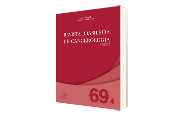Trk Inhibition Reduces Tumorsphere Formation and Changes Expression of Stemness Markers in SK-ES-1 Ewing Sarcoma Cells
DOI:
https://doi.org/10.32635/2176-9745.RBC.2023v69n4.4262Keywords:
Receptor, trkA, receptors, nerve growth factor, neoplastic stem cells, sarcoma, EwingAbstract
Introduction: Ewing sarcoma (ES) is a highly aggressive type of childhood cancer characterized by a chromosomal translocation resulting in fusions between the gene encoding EWS RNA Binding Protein 1 (EWSR1) and one gene of the ETS family, most frequently FLI-1, resulting in the EWS-FLI1 aberrant transcription factor. ES tumors can contain a subpopulation of cells showing cancer stem cell (CSC) features, which express stemness markers including CD133, OCT4 (Octamer-binding transcription factor 4), and NANOG, and display capacity to form tumorspheres likely enriched in CSCs. Neurotrophin (NT) receptors of the tropomyosin receptor kinase (Trk) family (TrkA, TrkB, and TrkC) may play a role in stimulating ES progression, but their possible role in CSCs remains unknown. Objective: To verify the effect of Trks inhibition on the formation of tumorspheres as well as the gene expression of stem markers. Method: The cells were dissociated and the formation of spheres was induced with supplemented culture medium and the K252a treatment was performed. After RNA extraction, mRNA expression levels of target genes Prom1 (CD133), OCT4 (POU5F1), SOX2, and Musashi-1 (MSI1) were analyzed by qPCR. Results: The pan-Trk inhibitor K252a (100 or 500 mM) hindered tumorsphere formation in human SK-ES-1 ES cell cultures. K252a also reduced mRNA expression of Prom1 (CD133-coding gene) while enhancing expression of OCT4. No changes in mRNA levels of SOX2 or Musashi-1 were observed. Conclusion: These findings provide the first evidence suggesting that Trk activity can influence stemness in ES cells.
Downloads
References
Balamuth NJ, Womer RB. Ewing's sarcoma. Lancet Oncol. 2010;11:184-92. doi: https://doi/org/10.1016/S1470-2045(09)70286-4 DOI: https://doi.org/10.1016/S1470-2045(09)70286-4
Crompton BD, Stewart C, Taylor-Weiner A, et al. The genomic landscape of pediatric Ewing sarcoma. Cancer Discov. 2014;4(11):1326-41. doi: https://doi.org/10.1158/2159-8290.CD-13-1037 DOI: https://doi.org/10.1158/2159-8290.CD-13-1037
Ross KA, Smith NA, Murawski CD, et al. The biology of Ewing sarcoma. ISRN Oncol. 2013;2013;759725. doi: https://doi.org/10.1155/2013/759725 DOI: https://doi.org/10.1155/2013/759725
Grier HE, Krailo MD, Tarbell NJ, et al. Addition of ifosfamide and etoposide to standard chemotherapy for Ewing’s sarcoma and primitive neuroectodermal tumor of bone. N Engl J Med. 2003;348(8):694-701. doi: https://doi.org/10.1056/nejmoa020890 DOI: https://doi.org/10.1056/NEJMoa020890
Suvà ML, Riggi N, Stehle JC, et al. Identification of cancer stem cells in Ewing's sarcoma. Cancer Res 69(5):1776-81. https://doi.org/10.1158/0008-5472.can-08-2242 DOI: https://doi.org/10.1158/0008-5472.CAN-08-2242
Hotfilder M, Mallela N, Seggewiß J, et al. Defining a characteristic gene expression set responsible for cancer stem cell-like features in a sub-population of Ewing sarcoma cells CADO-ES1. Int J Mol Sci. 2018;19:3908. https://doi.org/10.3390/ijms19123908 DOI: https://doi.org/10.3390/ijms19123908
Santos RP, Gregianin L, Brunetto AT, et al. Cancer stem cells and chemoresistance in Ewing sarcoma. Curr Stem Cell Res Ther. 2023;18(7):926-36. doi: https://doi.org/10.2174/1574888x17666220627114710 DOI: https://doi.org/10.2174/1574888X17666220627114710
Okugawa Y, Tanaka K, et al. Brain-derived neurotrophic factor/tropomyosin-related kinase B pathway in gastric cancer. Br J Cancer. 2013;108(1):121-30. doi: https://doi.org/10.1038/bjc.2012.499 DOI: https://doi.org/10.1038/bjc.2012.499
Bibel M, Barde YA. Neurotrophins: key regulators of cell fate and cell shape in the vertebrate nervous system. Genes Dev. 2000;14(23):2919-37. doi: https://doi.org/10.1101/gad.841400 DOI: https://doi.org/10.1101/gad.841400
Park H, Poo MM. Neurotrophin regulation of neural circuit development and function. Nat Rev Neurosci. 2013;14(1):7-23. doi: https://doi.org/10.1038/nrn3379 DOI: https://doi.org/10.1038/nrn3379
Schecterson LC, Bothwell M. Neurotrophin receptors: Old friends with new partners. Dev Neurobiol. 2010;70(5):332-8. doi: https://doi.org/10.1002/dneu.20767 DOI: https://doi.org/10.1002/dneu.20767
Bothwell M. Recent advances in understanding neurotrophin signaling. F1000Res. 2016;28:5:F1000. doi: https://doi.org/10.12688/f1000research.8434.1 DOI: https://doi.org/10.12688/f1000research.8434.1
Thiele CJ, Li Z, McKee AE. On Trk--the TrkB signal transduction pathway is an increasingly important target in cancer biology. Clin Cancer Res 2009;15:5962-7. doi: https://doi/org/10.1158/1078-0432.CCR-08-0651 DOI: https://doi.org/10.1158/1078-0432.CCR-08-0651
Roesler R, Farias CB, Abujamra AL, et al. BDNF/TrkB signaling as an anti-tumor target. Expert Rev Anticancer Ther. 2011;11:1473-5. doi: https://doi.org/10.1586/era.11.150 DOI: https://doi.org/10.1586/era.11.150
Heinen TE, Santos RP, Rocha A, et al. Trk inhibition reduces cell proliferation and potentiates the effects of chemotherapeutic agents in Ewing sarcoma. Oncotarget 2016;7(23):34860-80. doi: https://doi.org/10.18632/oncotarget.8992 DOI: https://doi.org/10.18632/oncotarget.8992
Souza BK, Costa Lopez PL, Menegotto PR, et al. Targeting histone deacetylase activity to arrest cell growth and promote neural differentiation in Ewing sarcoma. Mol Neurobiol. 2018;55(9):7242-58. doi: https://doi.org/10.1007/s12035-018-0874-6 DOI: https://doi.org/10.1007/s12035-018-0874-6
Conselho Nacional de Saúde (BR). Resolução n° 510, de 7 de abril de 2016. Dispõe sobre as normas aplicáveis a pesquisas em Ciências Humanas e Sociais cujos procedimentos metodológicos envolvam a utilização de dados diretamente obtidos com os participantes ou de informações identificáveis ou que possam acarretar riscos maiores do que os existentes na vida cotidiana, na forma definida nesta Resolução [Internet]. Diário Oficial da União, Brasília, DF. 2016 maio 24 [acesso 2023 dez. 28]; Seção I:44. Disponível em: http://bvsms.saude.gov.br/bvs/saudelegis/cns/2016/res0510_07_04_2016.html
Komuro H, Saihara R, Shinya M, et al. Identification of side population cells (stem-like cell population) in pediatric solid tumor cell lines. J Pediatr Surg. 2007;42(12):2040-5. doi: https://doi.org/10.1016/j.jpedsurg.2007.08.026 DOI: https://doi.org/10.1016/j.jpedsurg.2007.08.026
Cornaz-Buros S, Riggi N, Devito C, et al. Targeting cancer stem–like cells as an approach to defeating cellular heterogeneity in Ewing sarcoma. Cancer Res. 2014;74(22):6610-22. doi: https://doi.org/10.1158/0008-5472.CAN-14-1106 DOI: https://doi.org/10.1158/0008-5472.CAN-14-1106
Fujii H, Honoki K, Tsujiuchi T, et al. Sphere-forming stem-like cell populations with drug resistance in human sarcoma cell lines. Int J Oncol. 2009;34(5):1381-6. DOI: https://doi.org/10.3892/ijo_00000265
Guzel Tanoglu E, Ozturk S. miR-145 suppresses epithelial-mesenchymal transition by targeting stem cells in Ewing sarcoma cells. Bratisl Lek Listy. 2021;122(1):71-7. doi: https://doi.org/10.4149/bll_2021_009 DOI: https://doi.org/10.4149/BLL_2021_009
Riggi N, Suvà ML, De Vito C, et al. EWS-FLI-1 modulates miRNA145 and SOX2 expression to initiate mesenchymal stem cell reprogramming toward Ewing sarcoma cancer stem cells. Genes Dev. 2010;24(9):916-32. doi: https://doi.org/10.1101/gad.1899710 DOI: https://doi.org/10.1101/gad.1899710
Forouzanfar M, Lachinani L, Dormiani K, et al. Intracellular functions of RNA-binding protein, Musashi1, in stem and cancer cells. Stem Cell Res Ther. 2020;11:193. doi: https://doi.org/10.1186/s13287-020-01703-w DOI: https://doi.org/10.1186/s13287-020-01703-w
Hu J, Qin K, Zhang Y, et al. Downregulation of transcription factor Oct4 induces an epithelial-to-mesenchymal transition via enhancement of Ca2+ influx in breast cancer cells. Biochem Biophys Res Commun. 2011;411:786-91. doi: https://doi/org/10.1016/j.bbrc.2011.07.025 DOI: https://doi.org/10.1016/j.bbrc.2011.07.025
Published
How to Cite
Issue
Section
License
Os direitos morais e intelectuais dos artigos pertencem aos respectivos autores, que concedem à RBC o direito de publicação.

This work is licensed under a Creative Commons Attribution 4.0 International License.









